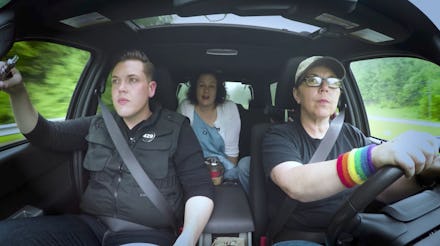The ‘Queer Ghost Hunters’ webseries aims to end the erasure of gay ghosts

The fight for better representation of LGBTQ people spans far and wide: in politics, film, gaming, fashion — the list goes on. And now, a YouTube web series is tackling queer erasure in a space you’ve probably never considered: ghost hunting.
“We always assume that ghosts are heterosexual,” Shane McClelland, co-founder of the Stonewall Columbus Queer Ghosthunters, says in the first episode of Queer Ghost Hunting’s second season.
In that episode, McClelland, along with group co-founder Lori Gum and their entire crew of ghost hunters, visit Ohio State Reformatory — the facility where The Shawshank Redemption was filmed — in order to get in touch with the ghosts of prisoners who likely would have identified as queer in 2017.
In case you’re wondering: Don’t worry, it’s OK to laugh about the idea of queer ghost hunting. The show’s creators and stars are laughing, too.
“It was really important for me to poke fun at my genre a little bit and have fun with the way-too-seriousness of ghost hunting shows in general,” Stu Maddux, a documentary filmmaker and director of Queer Ghost Hunters said in a phone interview.
For example, the first season’s title sequence parodies the melodrama of shows like Ghost Hunters and Ghost Adventures, swapping out some people’s ghost detection apparatuses with gay pride flags, or including footage of Gum poking McClelland’s face while he’s trying to pose for the camera. In the first episode, a camera inexplicably collides with a spooky-looking gargoyle, creating a loud “bonk” sound that undermines any sort of spookiness the shot might’ve normally elicited.
Of course, that’s not to say the people making Queer Ghost Hunters think this is all one big joke.
“As they were going out to find these places, they were finding these amazing stories of lost lives in the process, and it was kind of like, ‘Oh yeah, this is what’s making us different, is this history we’re finding,’” Maddux said. “And then they’re going out and contacting those people who lived that history in that spot.”
In short, Queer Ghost Hunters is almost more about teaching viewers small bits of queer history than it is about the process of ghost hunting. It’s about getting the LGBTQ community interested in the history of oppression and secret, hidden lives their predecessors led. Gay ghosts are just an accessible, interesting vector the show uses to do that.
But that’s not the way it started. In fact, McClelland and Gum met through an old-fashioned, heterosexual ghost hunting group. In a phone interview, McClelland said he’s been interested in ghost hunting ever since he was little, when he lived in a house near Columbus, Ohio, that he said was haunted.
“When I was 8 or 9, I remember being woken up with something touching me,” he said. “And you could see this hand that was on me, and it wasn’t mom or dad checking on me. It was this electric blue color that was kind of glowing, and that was the first time in my mind that I actually saw a ghost.”
McClelland said that, along with other “weird, idiosyncratic things that happened” in the house — like his stereo turning on without explanation or doors shutting on their own — sparked his interest in the paranormal.
But not everyone will be convinced by the methods the queer ghost hunters use to detect gay apparitions. For example, several episodes feature its stars using dousing rods: L-shaped metal rods that believers say ghosts can manipulate to communicate with the living, crossing them or uncrossing them to answer yes-or-no questions. (Studies have shown that the “ideomotor effect” is likely the culprit for the rods’ movements.)
But whether or not you’re a believer isn’t really the point.
“It would be great if in three or four years everybody was doing their own queer ghost hunts at their pride center for Halloween,” Maddux said. “And in that way, kind of raising the interest in queer history in their area. That would be a success.”